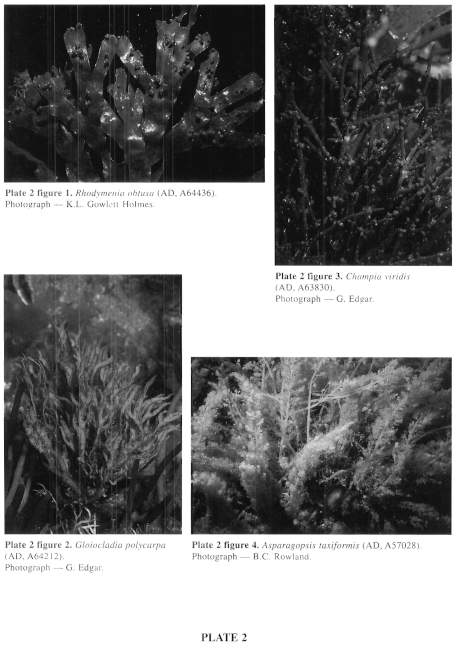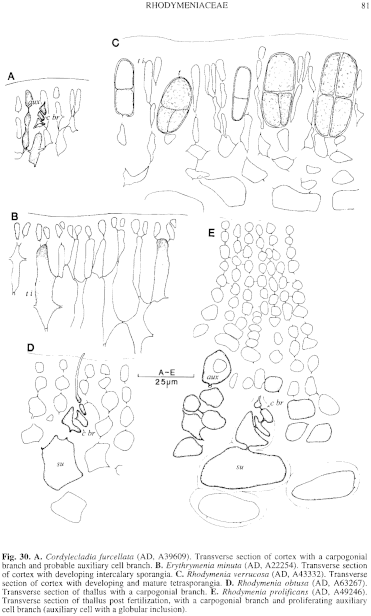|
|
|
|
|
|||||||||||
|
Electronic Flora of South Australia Species Fact Sheet
Phylum Rhodophyta – Class Florideophyceae – Order Rhodymeniales – Family Rhodymeniaceae
Synonyms
Phyllophora obtusa Greville 1831: 148, pl. 4 figs 1–5.
Phyllophora obtusa var. crispata Sonder 1848: 171.
Epymenia obtusa (Greville) Kützing 1849: 787; 1869: 15, pl. 40a, b. J. Agardh 1851: 220; 1892: 93. Etcheverry 1986: 281. Harvey 1863, synop.: xlv. Kylin 1931: 22. Sparling 1957: 350, figs 9a-g, 10, pls 51a, 52, 53.
Epymenia wilsonis Sonder 1855: 516; 1881: 18. Adams 1994: 234, pl. 83 lower right. J. Agardh 1892: 92. Chapman & Dromgoole 1970: 129, pl. 42 (upper). De Toni 1900b: 526. Guiler 1952: 94. Harvey 1863, synop.: xlv. Kylin 1931: 22, fig. 7, pl. 10 fig. 23. May 1965: 407. Sparling 1957: 348. Tisdall 1898: 506.
Epymenia membranacea Harvey 1859a: pl. 89; 1859b: 326. J. Agardh 1876: 334; 1878: 20; 1892: 93. De Toni 1900b: 527. Kützing 1869: 15, pl. 40c-e. Kylin 1931: 23. May 1965: 407. Sonder 1881: 18. Sparling 1957: 348. Tisdall 1898: 506. Wilson 1892: 178.
Thallus (Fig. 28A) dark red to red-brown, (5–) 10–25 cm high, fronds complanately branched with subdichotomous to alternate branches at intervals of mostly 2–6 cm, branches flat, 0.5–1.5 cm broad (broadest in cooler water specimens) with broadly rounded apices and a midrib present in lower fronds; proliferous laterals frequent from the midrib or centre of frond, 1–8 cm long, with small ovate to branched proliferations usually present, often in patches, and which become fertile; stipe compressed, 5–20 mm long and 0.5–1 mm broad. Holdfast crustose, 1–5 mm across, bearing 1-several fronds; epilithic. Structure multiaxial, developing a cortex (Fig. 28B) 2–3 cells thick, outer cells ovoid and 3–5 µm in diameter, grading over 2–4 cells to the medulla, 3–5 (–8) cells broad, inner larger cells ovoid and 30–60 µm in diameter, medulla becoming 8–20 cells thick in older parts (Fig. 28B) with intermixed larger and smaller cells. Midrib formed by secondary cortical development; stipe (Fig. 28C) medulla 20–30 cells across, with a secondary cortex. Rhodoplasts discoid to elongate, ribbon like in medullary cells.
Reproduction: All reproductive structures borne on the small proliferations, which are mostly ovate and 2–4 mm long, occasionally irregularly branched. Gametangial thalli dioecious. Carpogonial branches (Fig. 30D) 4-celled, with 3-celled auxiliary cell branches, borne on inner cortical cells. Carposporophyte (Fig. 28D) with a basal, erect, fusion complex of several elongate cells and a dense mass 500–700 µm across of ovoid to angular carposporangia 10–18 µm in diameter. Basal nutritive tissue slight, erect filaments disintegrating early apart from a few stellate cells. Cystocarps (Fig. 28D) on both sides of the proliferations, sessile, basally constricted, 0.75–1.5 mm across, pericarp 180–350 µm and 10–20 cells thick, inner cells stellate, outer cells in anticlinal chains, with a depressed ostiole. Spermatangia (Fig. 28E) covering the surface, cut off from elongate initials on outer cortical cells, ovoid, 2–2.5 µm in diameter.
Tetrasporangia in nemathecia (Fig. 28F) among extended cortical filaments 30–45 µm and 3–4 cells long, intercalary in mid cortical cells with pit-connections to outer cortical cells, ovoid, 20–45 µm long and 10–25 µm in diameter, irregularly decussately divided.
Type from Cape of Good Hope, South Africa (from Bowie); in E?
Selected specimens: Topgallant I., Investigator Group, S. Aust., 27 m deep (Turner, 29.iii.1982; AD, A53057). Port Elliot, S. Aust., drift (Womersley, 20.ix.1959; AD, A23148). Robe, S. Aust., 3 m deep on jetty piles (Kildea & Collings, 26.ix.1992; AD, A62828). Nora Creina, S. AWL, shaded pool (Womersley, 1.xi.1993; AD, A63253). Cape Northumberland, S. Aust., completely shaded pool 10–30 cm deep (Womersley, 24.ii.1992; AD, A61616 and 1.xi.1993; AD, A63267). Warrnambool, Vic., upper sublittoral (Womersley, 13.iv.1959; AD, A22896). Port Phillip Heads, Vic., 10 m deep (Watson, 8.iii.1985; AD, A57040). Gabo I., Vic., 13 m deep (Shepherd, 14.ii.1973; AD, A43334). Two Mile Creek, St Patricks Head, E Tas., 6 m deep (AIMS-NCI, Q66C 3707-U, 26.ii.1990; AD, A60344). Peggy Point, Bicheno, Tas., upper sublittoral pools (Wollaston & Mitchell, 2.iii.1964; AD, A27835). Stapleton Point, Prosser Bay, Tas., 3–6 m deep (Shepherd, 10.ii.1970; AD, A35738). Tesselated Pavement, Eaglehawk Neck, Tas., 0–1 m deep (Brown & Kenchington, 16.x.1986; AD, A57612). Canoe Bay, Fortescue Bay, Tas., 2–3 m deep (Gowlett-Holmes, 22.vi.1995; AD, A64436). Fluted Cape, Bruny I., Tas., 1–5 m deep (Shepherd, 11.ii.1972; AD, A41754) and 0–6 m deep (Shepherd, 12.ii.1972; AD, A41872).
Distribution: South Africa, New Zealand, southern South America.
In southern Australia, from Topgallant I., S. Aust. (mainly from Robe), to Gabo I., Vic., and around Tasmania.
Taxonomic notes: R. obtusa specimens in south eastern Australia are usually narrower in branch width, especially those specimens towards the extremes of the range; some, however, compare well with South African specimens (i.e. 1–1.5 cm broad) and in view of the structural and reproductive similarities it seems best to interpret R. obtusa as variable in branch width and include E. wilsonis and E. membranacea as synonyms, as did Sparling (1957, p. 348).
The lectotype of E. wilsonis Sonder, from Wilsons Prom., Vic., is in MEL, 674904; it is a relatively slender specimen with prominent proliferous laterals from the central thallus. The type of E. membranacea Harvey, from Georgetown, Tas., is in Herb. Harvey, TCD, and, as illustrated by Harvey (1859a, pl. 89) has proliferous, fertile, leaflets on the thallus surface.
References:
ADAMS, N.M. (1994). Seaweeds of New Zealand. (Cant. Univ. Press: Christchurch.)
AGARDH, J.G. (1851). Species Genera et Ordines Algarum. Vol. 2, Part 1, I-XII, 1–336 + index. (Gleerup: Lund.)
AGARDH, J.G. (1876). Species Genera et Ordines Algarum. Vol. 3, Part 1 — Epicrisis systematis Floridearum, pp. i-vii, 1–724. (Weigel: Leipzig.)
AGARDH, J.G. (1878). De Algis Novae Zelandiae marinis. Acta Univ. lund. 14, 1–32.
AGARDH, J.G. (1892). Analecta Algologica. Acta Univ. lund. 28, 1–182, Plates 1–3.
CHAPMAN, V.J. & DROMGOOLE, F.I. (1970). The marine algae of New Zealand, Part III: Rhodophyceae. Issue 2: Florideophycidae: Rhodyméniales, pp. 115–154, Plates 39–50. (Cramer: Germany.)
DE TONI, G.B. (1900b). Sylloge Algarum omnium hucusque Cognitarum. Vol. 4. Florideae. Sect. 2, pp. 387–776. (Padua.)
ETCHEVERRY, D.H. (1986). Algas Marinas Bentónicas de Chile. (Unesco: Montevideo.)
GREVILLE, R.K. (1831). Description of two new species of marine algae. Edinb. J. Nat. Geogr. Sci., n.s., 3, 148–150, Plate 4.
GUILER, E.R. (1952). The marine algae of Tasmania. Check List with localities. Pap. Proc. R. Soc. Tasm. 86, 71–106.
HARVEY, W.H. (1859a). Phycologia Australica. Vol. 2, Plates 61–120. (Reeve: London.)
HARVEY, W.H. (1859b). Algae. In Hooker, J.D., The Botany of the Antarctic Voyage. HI Flora Tasmaniae. Vol. II, pp. 282–320. (Reeve: London.)
HARVEY, W.H. (1863). Phycologia Australica. Vol. 5, Plates 241–300, synop., pp. i-lxxiii. (Reeve: London.)
KÜTZING, F.T. (1849). Species Algarum. (Leipzig.)
KÜTZING, F.T. (1869). Tabulae Phycologicae. Vol. 19. (Nordhausen.)
KYLIN, H. (1931). Die Florideenordnung Rhodyméniales. Lunds Univ. Årsskr. N.F. Avd. 2, 27 (11), 1–48, Plates 1–20.
MAY, V. (1965). A census and key to the species of Rhodophyceae (red algae) recorded from Australia. Contr. N.S.W. natn. Herb. 3, 349–429.
SONDER, O.W. (1848). Algae. In Lehmann, C., Plantae Preissianae. Vol. 2, pp. 161–195. (Hamburg.)
SONDER, O.W. (1855). Algae annis 1852 et 1853 collectae. Linnaea 26, 506–528.
SONDER, O.W. (1881). In Mueller, F., Fragmenta Phytographiae Australiae. Supplementum ad volumen undecinum: Algae Australianae hactenus cognitae, pp. 1–42, 105–107. (Melbourne.)
SPARLING, S.R. (1957). The structure and reproduction of some members of the Rhodymeniaceae. Univ. Calif Pubis Bot. 29, 319–396.
TISDALL, H.T. (1898). The algae of Victoria. Rep. 7th Meet. Aust. Ass. Adv. Sci., Sydney, 1898, pp. 493–516.
WILSON, J.B. (1892). Catalogue of algae collected at or near Port Phillip Heads and Western Port. Proc. R. Soc. Vict. 4, 157–190.
The Marine Benthic Flora of Southern Australia Part IIIB complete list of references.
Publication:
Womersley, H.B.S. (28 June, 1996)
The Marine Benthic Flora of Southern Australia
Rhodophyta. Part IIIB. Gracilarialse, Rhodymeniales, Corallinales and Bonnemaisoniales
Reproduced with permission from The Marine Benthic Flora of Southern Australia Part IIIB 1996, by H.B.S. Womersley. Australian Biological Resources Study, Canberra. Copyright Commonwealth of Australia.
Illustrations in Womersley Part IIIA, 1996: PLATE 2 fig. 1; FIGS 28, 30D.

Plate 2 enlarge
PLATE 2
figure 1. Rhodymenia obtusa (AD, A64436). Photograph - K.L.Gowlett-Holmes.
figure 2. Gloiocladia polycarpa (AD, A64212). Photograph - G. Edgar.
figure 3. Champia viridis (AD, A63830). Photograph - G. Edgar.
figure 4. Asparagopsis taxiformis (AD, A57028). Photograph - B.C.Rowland.

Figure 28 enlarge
Fig. 28. Rhodymenia obtusa (A–D, F, AD, A41872; E, AD, A57040). A. Habit. B. Transverse section of branch. C. Transverse section of stipe with secondary cortex. D. Section of cystocarp. E. Transverse section of male thallus with spermatangia. F. Transverse section of branch with tetrasporangia.

Figure 30 enlarge
Fig. 30. A. Cordylecladia furcellata (AD, A39609). Transverse section of cortex with carpogonial branch and probable auxiliary cell branch. B. Erythrymenia minuta (AD, A22254). Transverse section of cortex with developing intercalary sporangia. C. Rhodymenia verrucosa (AD, A43332). Transverse section of cortex with developing and mature tetrasporangia. D. Rhodymenia obtusa (AD, A63267). Transverse section of thallus with a carpogonial branch. E. Rhodymenia prolificans (AD, A49246). Transverse section of thallus post fertilization, with a carpogonial branch and proliferating auxiliary cell branch (auxiliary cell with a globular inclusion).

|
Email Contact: State Herbarium of South Australia |

|